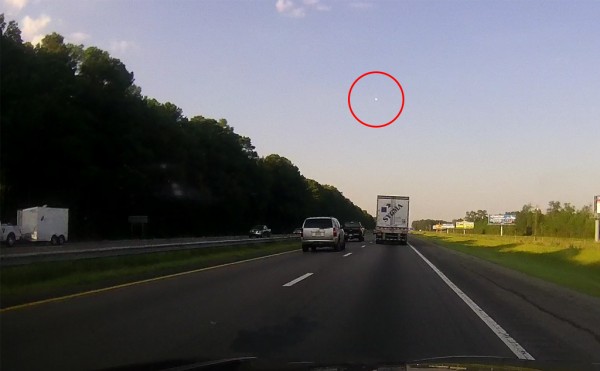By Ana Verayo, | September 12, 2016

Dash-cam image of the image taken along I-95
Residents across Virginia and North Carolina are still stunned by a mysterious sky event that occurred last Thursday when a fireball streaked daytime skies around 5:30 to 6 P.M. local time.
According to the American Meteor Society, a fireball is classified as a very bright meteor that shines in equal magnitude as Venus during the morning or evening.
Like Us on Facebook
The AMS is also in charge of collecting data about these sky sightings where this recent fireball event was reported by 253 locals from Virginia, North Carolina and South Carolina.
Locals describe the fireball as light yellow in color leaving behind orange red sparks behind it, where a blue streak was emitted on its tail end.
When it comes to fireball reports, the AMS asks local residents to report as much detail as possible and observe properties like brightness and length of the fireball streak across the skies, along with its color and duration.
Witnesses are also asked to determine the beginning and end points of the fireball across the skies' constellations or direction, including its angle and elevation above the horizon.
Fireball sightings last September 9, Thursday can also be accessed via the AMS website as the organization also shares its data with other agencies for studies and statistics.
Not only in the United States, this fireball was also seen around the globe, where a total of 456 reports were filed since Monday.
According to Department of Astronomy professor Ed Murphy from the University of Virginia, AMS is a good source of information about these fireballs as he describes fireballs as a particularly bright meteor.
Murphy adds that this unique fireball last Thursday was very rare, as it was seen during daytime. He adds that there are multiple fireball sightings happening throughout the world at any given time however, they are most likely to occur over bodies of water where no humans are there to see them.
-
Use of Coronavirus Pandemic Drones Raises Privacy Concerns: Drones Spread Fear, Local Officials Say

-
Coronavirus Hampers The Delivery Of Lockheed Martin F-35 Stealth Fighters For 2020

-
Instagram Speeds Up Plans to Add Account Memorialization Feature Due to COVID-19 Deaths

-
NASA: Perseverance Plans to Bring 'Mars Rock' to Earth in 2031

-
600 Dead And 3,000 In The Hospital as Iranians Believed Drinking High-Concentrations of Alcohol Can Cure The Coronavirus

-
600 Dead And 3,000 In The Hospital as Iranians Believed Drinking High-Concentrations of Alcohol Can Cure The Coronavirus

-
COVID-19: Doctors, Nurses Use Virtual Reality to Learn New Skills in Treating Coronavirus Patients







